Christmas Moss is a versatile plant that can be used as walls, hardscapes, or even a cover for aquarium decorations. It can provide shelter to the fry and is a great food source for aquarium life.
With this guide, we will teach you everything you need to know when growing Christmas Moss in your Aquarium. So, if you are interested to know more please go through the whole article!
What is Christmas Moss (Vesicularia montagnei)?
Jump To
- 1 What is Christmas Moss (Vesicularia montagnei)?
- 2 How To Identify?
- 3 Is Christmas Moss Easy To Grow
- 4 How they looks like
- 5 Distribution & Natural Habitat
- 6 One look care guide
- 7 Aquarium Care Requirements
- 8 Can You Float Christmas Moss?
- 9 How To Keep Christmas Moss Alive
- 10 How Do You Propagate Christmas Moss?
- 11 Can Christmas Moss Grow Out Of Water?
- 12 Christmas Moss Tank mates
- 13 Diseases and Common Problems
- 14 How To Make Christmas Moss Carpet
- 15 Christmas Moss VS Java Moss
- 16 Types Of Christmas Moss
- 17 How To Attach Christmas Moss
- 18 Why Christmas Moss Turning Brown
- 19 Related Questions
- 20 Is Christmas Moss Good For Shrimp?
- 21 Can You Hot Glue Living Moss?
- 22 Final Thoughts
Christmas Moss is one of the most extensively grown aquarium mosses worldwide. Its unique branch structure resembles a Christmas tree. Because of that reason, they got its name.
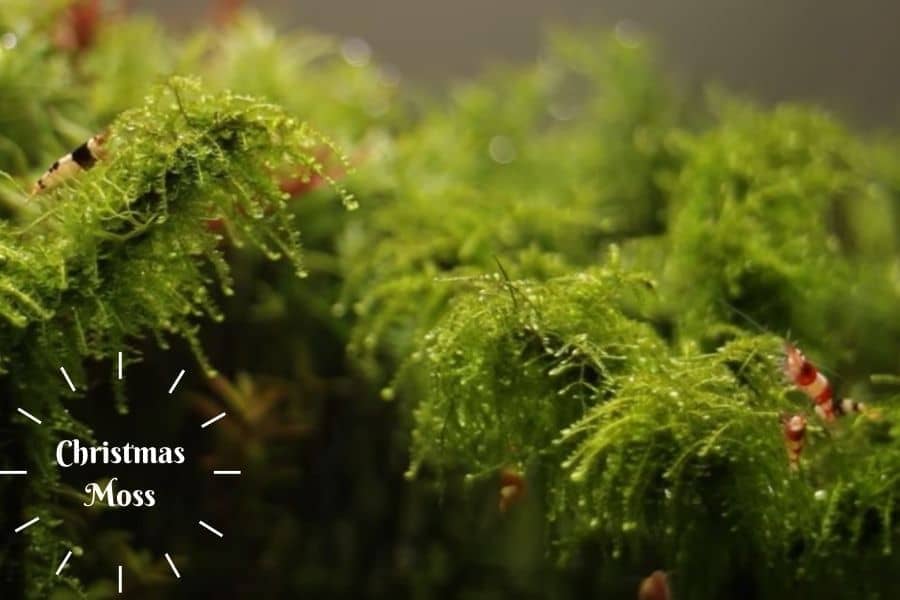
The scientific name of Christmas moss is Vesicularia montagnei. It is found mainly in tropical countries such as Australia, China, Japan, India, Indonesia, the Philippines, Sri Lanka, Thailand, Sudan, and Vietnam.
How To Identify?
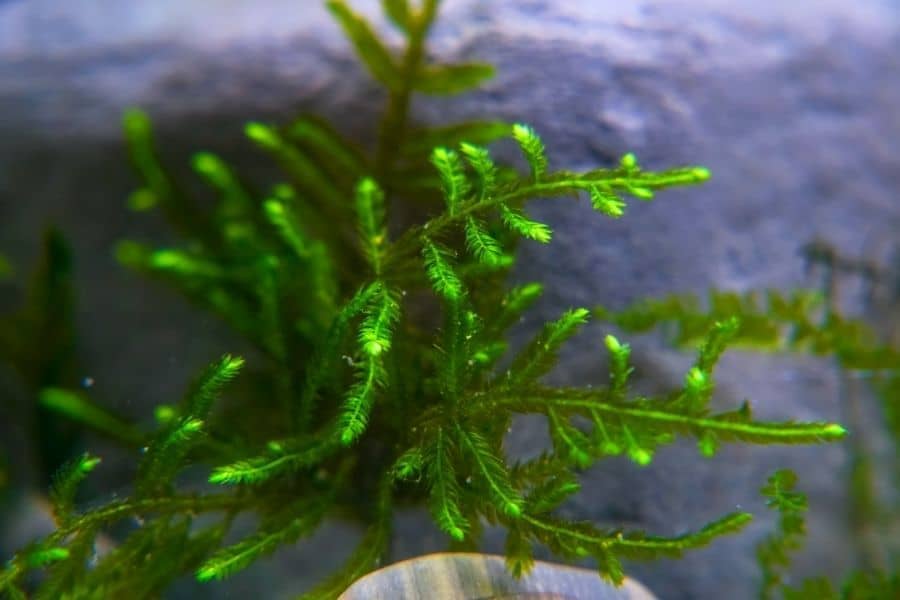
Many aquarists mistake Christmas moss with Java moss because of their almost similar look. But both plants have different characteristics that can be discovered when examined closely.
Christmas moss’s branch structure resembles a Christmas tree. The leaves of Java Moss are more delicate and stringy, while the leaves of Christmas moss are thicker.
Christmas moss is a little darker than Java moss when in bright light, but there will be no color difference between the two mosses in low light conditions.
Is Christmas Moss Easy To Grow
Yes. They are relatively easy to grow with proper care. Christmas moss is a slow-growing plant that needs care.
It requires a cleaner tank and good water flow around the plant to thrive. If given those requirements, Christmas moss will thrive well, providing an aesthetic look to your Aquarium.
How they looks like
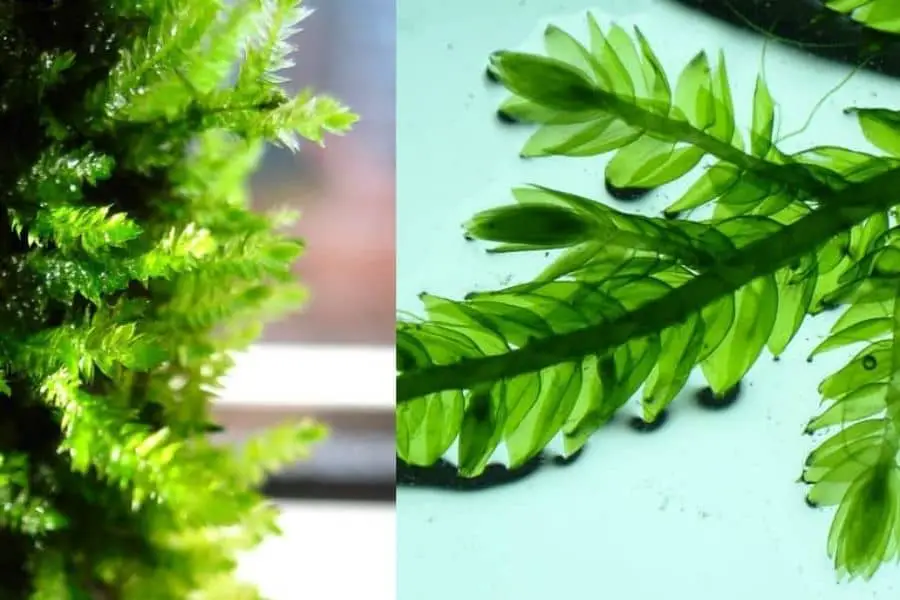
The Christmas Moss branches look like a Christmas tree. These branches grow overlapping each other, and they grow hanging downwards.
It has a darker green color than Java moss and has round or oval-shaped leaves that terminate at a sharp point.
Distribution & Natural Habitat
Christmas moss is native to tropical Asia. You can find Christmas moss naturally in damp situations on rocks and the trunks of the trees in Australia, China, Japan, India, Indonesia, the Philippines, Sri Lanka, Thailand, Sudan, and Vietnam.
It can also grow submerged underwater on shaded riverbanks, creeks, and streams.
One look care guide
| Scientific name | Vesicularia montagnei |
| Common name | Christmas moss |
| Care level | Easy |
| Native to | Australia, China, Japan, India, Indonesia, the Philippines, Sri Lanka, Thailand, Sudan, and Vietnam |
| Type | Plant |
| Preferred temperature | 65F to 77F. |
| pH | 5-7.5 |
| Lighting | Prefer brighter light |
| Fertilizer | Not necessary |
| Growth rate | Slow |
| Recommended tank mates | Crystal Red Shrimp (Caridina cantonensis) Cherry Shrimp (Neocaridina davidi) Otocinculus (Otocinclus sp.) Bristlenose Plecos (Ancistrus sp.) Pea Puffer (Carinotetraodon travancoricus) Angelfish (Pterophyllum scalare) Guppies (Poecilia reticulata) Hillstream Loach (Sewellia sp.) |
Aquarium Care Requirements
Christmas moss is a relatively easy-to-care aquarium plant, and it is easy to propagate, which makes it a good choice for a beginner aquarist. However, it does have some care requirements to thrive well in an aquarium.
Lighting
Christmas Moss can tolerate virtually all lighting conditions. It will survive in low to no light conditions as well as bright light conditions.
However, in brighter light, Christmas moss tends to grow faster, and in low light conditions, it will grow slower.
That said, you should not expose Christmas moss to direct sunlight for an extended period of time as the direct sunlight may harm the plants.
Fertilizers & Substrates
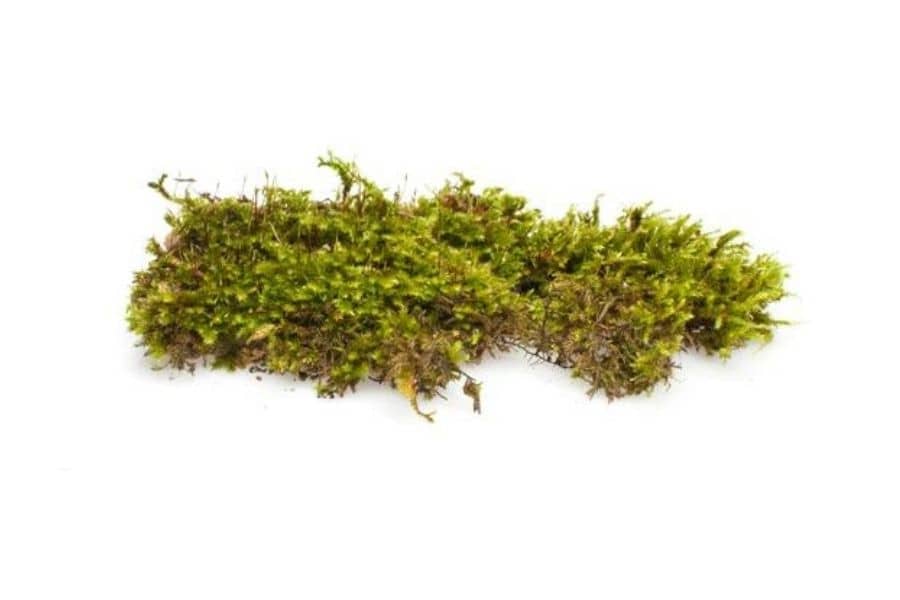
Fertilizers for Christmas moss are not necessary. However, if you provide fertilizers and CO2 to the water, it will grow healthier, and the growth rate will accelerate.
Christmas moss’s root structure is shallow. Hence, it can absorb nutrients directly from water, making it capable of growing pretty much anywhere. Because of this, Christmas moss doesn’t need any substrate in an aquarium to thrive.
Can Christmas Moss Grow On Sand?
If the moss is planted on the sand, it will die because the roots need open water to flow around it to absorb nutrients.
If you put a mesh on the sand and put the moss on the mesh, it will grow well on the sand, given that the root is not buried into the sand.
Water quality
Christmas moss is a freshwater plant. Therefore it will not survive in brackish or saltwater environments. The plant can tolerate a fairly wide temperature level from 65F to 77F.
Christmas moss enjoys growing in soft water with a pH level in the range between 5 and 7.5.
It is essential to keep your plant in clean water free from pollutants such as Ammonia. Christmas moss won’t grow in dirty water. The best place to place your Christmas moss is near the water filtration system because the plant prefers water movement.
Temperature
Christmas Moss will thrive in temperatures between 65F to 77F degrees.
Placement
You can put Christmas Moss anywhere in your tank, and it will grow well. However, many aquarists prefer to put Christmas Moss in the back, bottom, or side of the Aquarium to create a carpet or wall effect.
When placed on the bottom, the moss can provide a perfect hiding spot for fry and other small species.
Christmas moss is a perfect choice to create an aquascape wall. You can create a wall using mesh and fishing lines and train the plant to grow on the mesh. Christmas moss can also grow on stones, driftwood, and tree roots, enhancing the look of your tank.
The key to successful planting is letting the roots access water freely as it absorbs nutrients from the water.
Can You Float Christmas Moss?
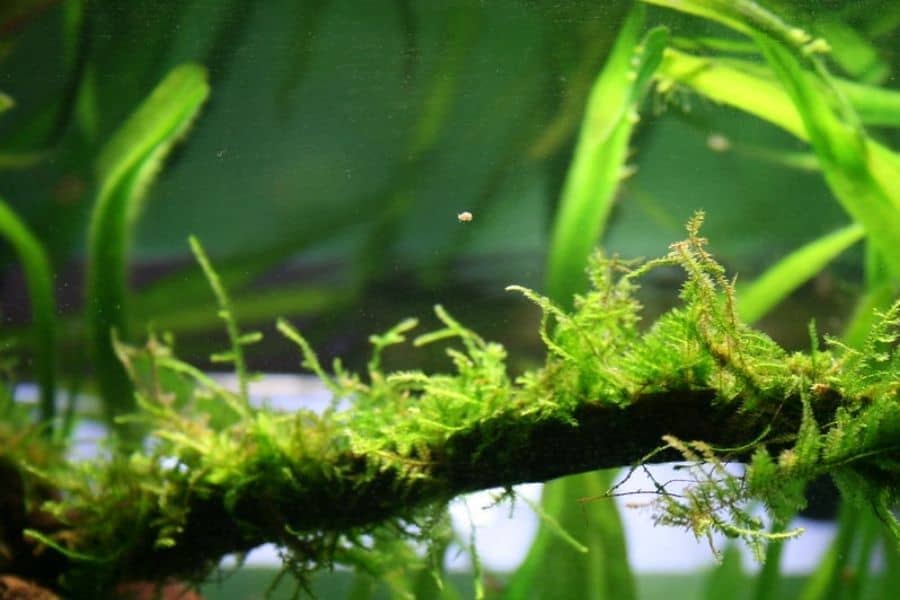
Yes. You can float Christmas moss as long as the filter current doesn’t move the moss around too much. Christmas Moss can grow submerged as well as emerge. However, the plant shouldn’t move much from place to place in order for the roots to grow.
How To Keep Christmas Moss Alive
If you provide adequate water and light conditions, Christmas moss will live in your Aquarium for a long time. Christmas moss doesn’t need any fertilizers or substrate to root the plant. It just needs clean water (preferably running water) and some light to thrive. So, keeping Christmas Moss alive is pretty straightforward.
How Fast Does Christmas Moss Grow
Christmas moss is not a fast-growing plant. It takes a long time to grow in any environment. You can, however, provide fertilizers and increased lighting to speed up growing but, even with those conditions, Christmas moss will not grow as fast as Java moss.
Although it is a slow-growing plant, it can form a beautiful carpet moss in a freshwater aquarium.
How To Trim Christmas Moss
You can trim Christmas Moss with a scissor. If the moss is attached to something that can take out from the tank, you can take it out and cut it in a bucket.
So that way you’ll have a cleaner tank. Otherwise, small pieces of Christmas moss branches will float around the tank and grow from somewhere else if you trim it from the inside.
Does Christmas Moss Need CO2
Christmas Moss doesn’t need CO2 to thrive. But, if you provide CO2 to the plant, it will grow faster and thicker.
How Do You Propagate Christmas Moss?
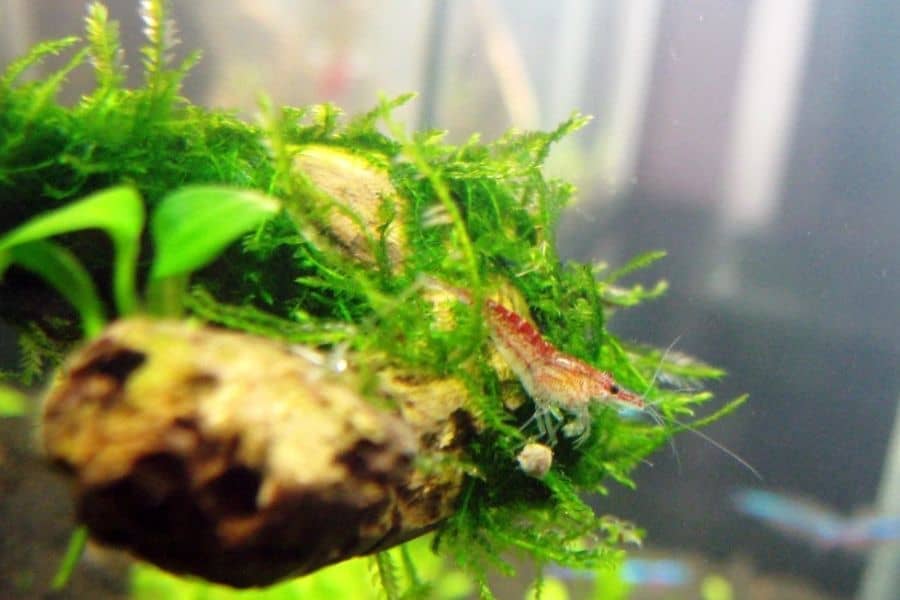
Propagating Vesicularia montagnei is quick and easy. You have to take a cutting from the original plant and attach it to the new site. You’ll have to take a decent-sized chunk. Otherwise, the pieces will float away once you put them in the water.
There are several ways to attach Christmas Moss to your desired site.
- Dry Start Method (DSM)
This is an advanced technique of attaching mosses to the tank base. Basically, you would start with an empty tank and add some soil as the substrate.
Then you will secure your moss to the soil and water it with a watering spray. Keep watering for several days/months till the moss grows.
You need to have patience and dedication to grow Christmas moss this way. That’s why only dedicated aquarists try out this method. HERE is a good video on how to try out this method.
- Anchoring with Super Glue
One of the easiest methods to attach Christmas Moss is to glue the pieces into the site. You simply have to take out the object and put some super glue to wherever you want the moss to grow and attach the pieces of Christmas moss to it. Once the adhesive cures, you can put the object back in the tank.
We recommend the gel version of the Original Super Glue for this method because many other brands are known to have mishaps once you put them back to the tank. This method is best when you want to attach the moss to a rock or something.
- Anchoring with thread or fishing line
Not the best option to attach moss but, you can use this method to apply moss into driftwood. You have to take the thread or fishing line, wrap it around the moss tight enough and hold it in place.
With this method, you won’t have much luck with rocks as the thread tries to unfold with rocks. And also, fish explorers may mess up the moss by nipping at them.
- Anchoring with a mesh
When wrapping with a thread or gluing is not an option, you can anchor the moss with a mesh. This method is proper when you want to grow a moss wall but not ready to give off the wall with glue.
You have to anchor the moss to the mesh with glue or cotton thread and put the mesh into your desired location. We find attaching with glue is the best method because the moss won’t try to unfold when we use superglue.
Can Christmas Moss Grow Out Of Water?
Yes. Christmas Moss can grow out of water. However, the Christmas Moss is a vascular plant that means it needs to have moisture all the time to grow.
If the moss gets dry for an extended period of time, it will die eventually. So, in reality, people don’t choose to grow Christmas Moss out of water because it is much more work.
However, if you grow Christmas moss out of the water, giving it the moisture it needs, the moss will grow faster than in the water.
Christmas Moss Tank mates
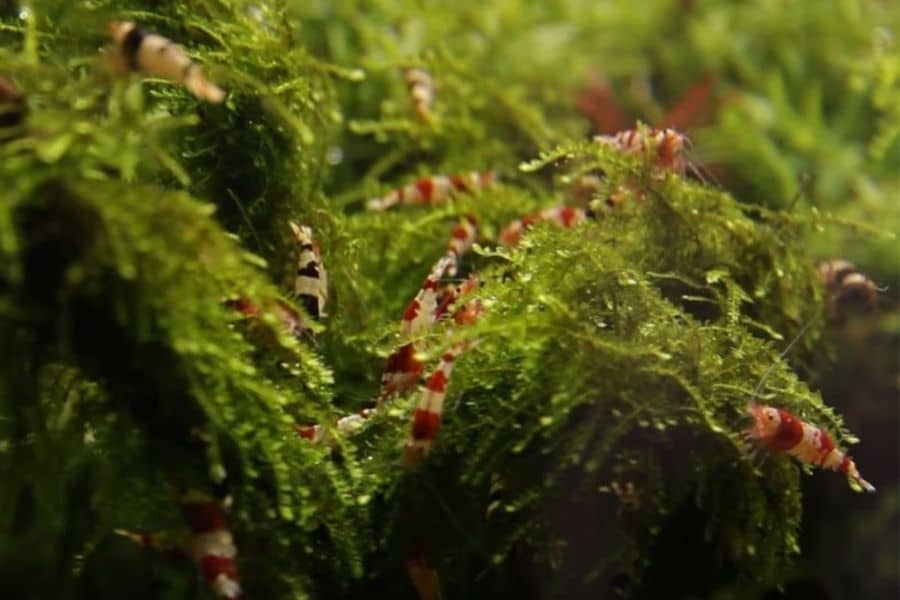
Christmas Moss gives an ideal environment for fish breeding and a place for fry and small species to hide. It is a good food source for omnivore fish and shrimps.
It will go well with other aquarium plants. However, you’ll have to avoid fish that need blackwater environments or overhead plants because Christmas Moss won’t provide shade for the fish.
Whatever fish you keep in your tank, never put Siamese Algae Eaters (SAE) in the tank with Aquarium mosses. Moss is the favorite meal of Siamese Algae Eaters.
Fish
Small fish will enjoy living with Christmas Moss, and shrimps love mosses. Christmas moss is a good food source for fish and other aquarium species. So, you can choose any fish that goes well with light.
Here is a list of suitable tank mates for Christmas Moss as a start.
- Crystal Red Shrimp (Caridina cantonensis)
- Cherry Shrimp (Neocaridina davidi)
- Otocinculus (Otocinclus sp.)
- Bristlenose Plecos (Ancistrus sp.)
- Pea Puffer (Carinotetraodon travancoricus)
- Angelfish (Pterophyllum scalare)
- Guppies (Poecilia reticulata)
- Hillstream Loach (Sewellia sp.)
Plants
Christmas moss is an excellent addition for aquascaping. You can use it as a carpet or a wall for your Aquarium. Christmas moss doesn’t get bothered by other plants unless it is algae.
If you are a starter aquascaper, you may go with easier plants like Amazon Swords, Cryptocoryne wendtii, Aponogeton Crispus, Java Fern, and Dwarf Sagittaria.
Christmas Moss is also compatible with other mosses and emergent plants as long as it gets enough light and clean water.
Other organisms
Christmas moss is a great hiding source and a food source for other organisms too. Some aquarium examples are shrimps and snails.
Diseases and Common Problems
Growing aquatic plants in an aquarium has many benefits as well as some drawbacks. Although Christmas Moss is an excellent source of food and shelter for the fish and other species, some common issues might arise when maintaining this plant.
Algae
Like other mosses, Christmas Moss is also an Algae Magnet. An imbalance in an aquarium, such as too much light, too little CO2, and excess Ammonia and Nitrates, can trigger Algae growth in an aquarium.
When an Algae bloom occurs in a tank, it mostly goes around this greenery, making it hard to remove without ruining the moss.
Christmas Moss Turning Brown
When they are turning brown, it means that the plant is dying. One cause for dying is that the lack of pruning.
You can recognize this issue easily as the fronds will die off from the inside out. Other causes for brown-colored Christmas Moss are lack of water flow, lack of nutrients, overly warm water temperature, or sudden changes in water consistency.
Identification
Each Aquatic moss has unique features, although they look similar to the naked eye. You need to check closely to identify Christmas Moss; otherwise, you may get mistaken for Java moss because of similar features.
However, Java moss has stringy leaves, while Christmas Moss has round, oval-shaped leaves. It is quite tricky to tell the two plants apart. So, there is an identification problem.
Parasitic Species and Diseases
This problem happens when you introduce Christmas Moss to your Aquarium from another source. The plant may have infected with parasitic species like white snails or other bacteria and viruses, which are fatal to your fish.
This is a severe problem for any aquatic plant. In this case, you’ll have to soak the plant in an Aluminium Sulfate solution for a while to get rid of white snails and soak in some antibacterial solution to disinfect the plant.
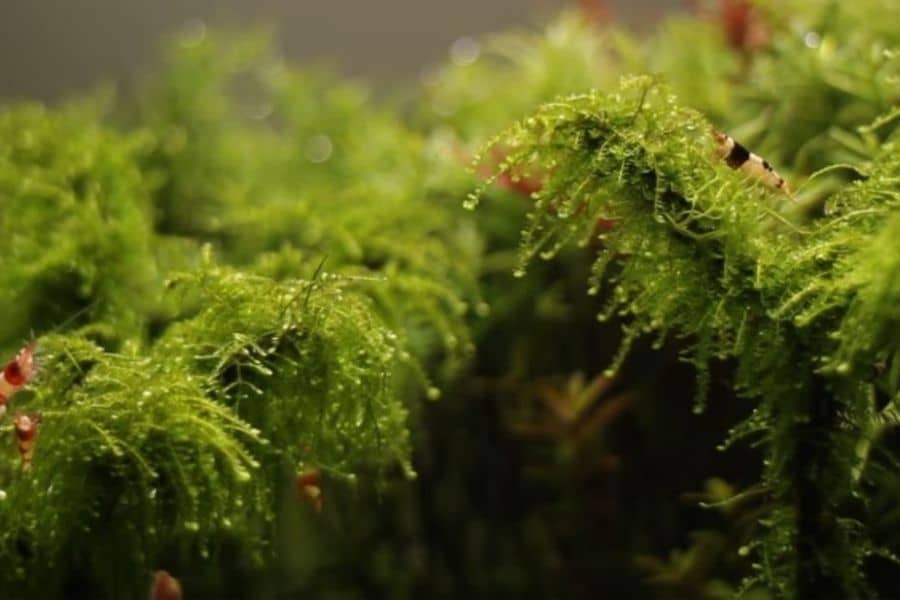
How To Make Christmas Moss Carpet
Making a Moss carpet is pretty straightforward. You can simply use a mesh to acquire this.
- Take a mesh for your desired carpet size.
- Attach small pieces of them plant to the mesh using glue or thread, or fishing lines. (We already explained these methods under “How Do You Propagate Christmas Moss.”)
- Put the mesh into your Aquarium or provide a consistent water flow to the mesh if you keep it outside.
- If you use plant fertilizers and provide CO2 to your Aquarium, the growth rate will increase. And if you provide bright light conditions (but not direct sunlight), it will also help with faster-growing.
Christmas Moss VS Java Moss
As we have discussed above, both Christmas Moss and Java Moss have quite a similar look, and both are easy to grow mosses. Both mosses can invite algae problems which should be controlled, however. Let’s discuss the differences between Christmas Moss and Java Moss.
| Christmas Moss | Java Moss |
| Leaves are rounded and oval-shaped | Leaves are trimmer |
| Grows better in warmer water | Grows better in cooler water |
| Slow growth rate | Fast growth rate |
| Need more trimming | Need little trimming |
| little light to grow | No need for light to grow |
| moderate care | No need for care |
Types Of Christmas Moss
Scientists recently named few variations of Christmas Mosses into the Vesicularia family. Below are some of them.
Christmas Moss (Vesicularia montagnei)
The original moss plant grows up to 3 to 4 inches tall and has fern-like branches that resemble a Christmas tree. The structure can change depending on the placement, lights, nutrients, and other factors, but the branches’ look doesn’t change.
Brazilian Christmas Moss (Vesicularia dubyana)
It has the same shape as Vesicularia montagnei, but it is more compact with shorter and narrower leaves. This plant is easily confused with peacock moss because of the look and Java moss because of the scientific name.
Mini Christmas Moss (Vesicularia sp. var. “Mini”)
This type moss grows even more compact than Brazillian Christmas Moss, and inner nodules are closer than Vesicularia montagnei and Vesicularia dubyana. The leaves also grow even closer together. Mini Christmas Moss will grow at the same height as Brazillian Christmas Moss. This plant is easily confused with Java moss.
How To Attach Christmas Moss
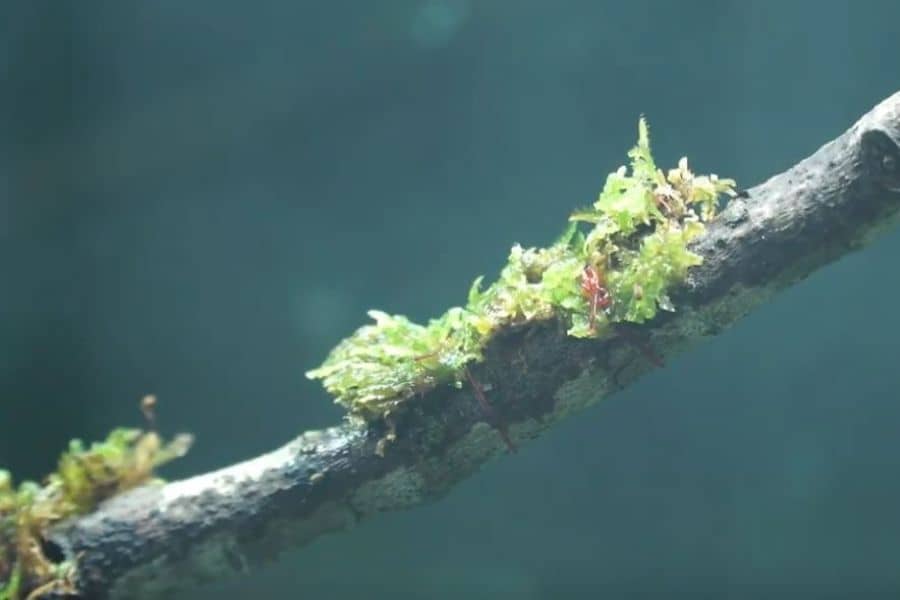
Attaching Christmas Moss is easy. You can use superglue (which is easiest), thread, mesh, or fishing lines to attach the plant.
How To Attach Christmas Moss To Driftwood
You can attach the Moss to driftwood with a thread, fishing line, or super glue gel. Each method of attaching them has explained above.
How To Attach Christmas Moss To Rocks
Attaching them into Rock is a little tricky. Threads and fishing lines tend to slip through rocks. Therefore, the best way is to use super glue gel. Glue the moss leaves to the rock, let it cure, and finally put the rock back to the tank.
How To Glue Moss To Plastic
You will have to use super glue gel to attach the moss to plastic.
How To Glue Moss To Fabric
You can either glue the leaves with super glue gel or sew them with a needle and thread. When sewing, be careful not to damage the leaves by sewing them so tighter as they need some space to “breathe.”
Why Christmas Moss Turning Brown
If your Christmas Moss is turning brown, it means that the plant is dying. This may happen for several reasons.
- Lack of pruning – they needs frequent trimming for proper growth. If left without trimming, it will start to dye from inside because of insufficient water flow.
- not enough of Water Flow – If you don’t provide enough moisture to the plant, the plant will die eventually.
- Nutrients – they doesn’t need many nutrients to grow but, sometimes it will die because of insufficient nutrients such as less CO2 and fertilizers.
- Warm Temperature – they prefers warmer water than Java moss, but if the temperature is too much, the plant will die (so is most other aquarium life).
- Sudden change in water consistency – Water changes can also affect them to die. For example, the plant may die right after buying plant.
Related Questions
Is Christmas Moss Good For Shrimp?
Yes. Christmas Moss is an excellent source of food and a good hiding spot for shrimp. Shrimps love eating all types of mosses, including Christmas moss. Though shrimps eat Christmas moss, they won’t damage the plant, such as Siamese Algae Eater.
Can You Hot Glue Living Moss?
No. Hot glue can damage the plant tissues causing the tissue to rot. If you use hot glue, the plant may die because of rotting. Better go with Superglue gel or thread or fishing lines.
Final Thoughts
Growing Christmas Moss is not a complicated task. You just have to have some patience and dedication to grow them in your Aquarium. Christmas Moss is not a fast-growing plant, but it provides a fresh and natural aesthetic look in your Aquarium when it is established in your tank.
The most important thing about growing them is attaching it to the object. It needs clean water and moderate light to thrive. If the requirements are fulfilled in your Aquarium (which is easy to acquire), Christmas Moss will freely grow in your tank in no time.
Read more : 21 Extra Tall Aquarium Plants For Your Aquarium | Full Guide
Related : 5 Best Substrate For Planted & Non Planted Betta Tank
